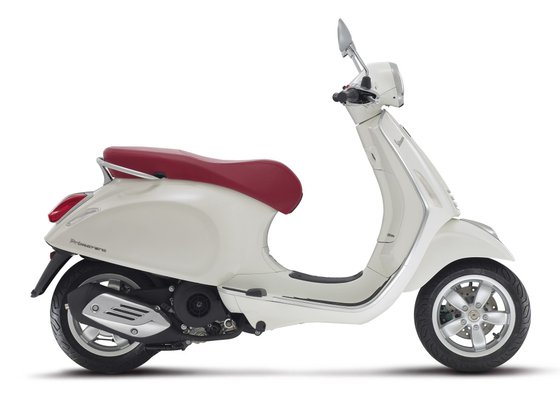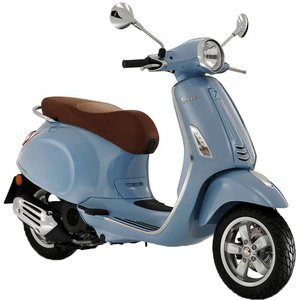Vespa Primavera 150 (2014-2017) Review: A Timeless Urban Companion Reimagined

Introduction
The Vespa Primavera 150 represents a harmonious blend of Italian design ethos and practical urban mobility. As part of Vespa's third-generation small-frame scooters, this 2014-2017 model iteration refined the brand's iconic style while addressing previous generations' shortcomings. Let's explore why this scooter remains a compelling choice for city riders and style-conscious commuters.
Design & Aesthetics

The Primavera's design pays homage to Vespa's 946 "luxury scooter" lineage while maintaining accessibility. Its angular front shield and triple front vent detailing create a more aggressive stance than the curved LX models it replaced. The 2016 update introduced LED lighting elements that modernized the package without sacrificing classic Vespa DNA.
Key design improvements include: - 11" wheels (front and rear) for improved stability - 5-spoke alloy wheels with premium finishes - Slimmer profile with 1,859mm (73.2") overall length - 780mm (30.7") seat height accessible for most riders - 8-liter (2.1 gal) fuel tank integrated seamlessly into the unibody
Color options evolved through the years, ranging from sophisticated metallics like Azzurro Marechiaro (2014) to bold solids like Rosso Dragon (2015). The 2017 models offered simplified palette choices focusing on core colors.
Riding Experience
Urban Performance
The air-cooled 155cc 3-valve engine delivers 12.7 HP @ 7,750 RPM, providing confident acceleration from 0-50 km/h (0-31 mph) in 5.2 seconds. The automatic CVT transmission eliminates gear-shifting hassles - twist the throttle and glide through traffic with 12.8 Nm (9.4 lb-ft) of torque available at 6,500 RPM.
Test ride observations: - Effortless low-speed maneuverability in tight spaces - Stable at top speed of 95 km/h (59 mph) - Improved high-speed stability vs older LX models - Noticeably smoother vibration damping compared to carbureted models
Suspension & Handling
The 1,339mm (52.7") wheelbase and revised suspension geometry address previous generations' nervousness at speed. The front single-arm suspension offers 78mm (3.1") of travel, while the rear monoshock provides 70mm (2.8") - sufficient for urban potholes but firm enough for spirited riding.
Key handling characteristics: - Light 126kg (278 lbs) dry weight enables easy parking - 11" wheels (110/70 front, 120/70 rear) enhance cornering confidence - Responsive 200mm front disc brake (140mm rear drum) - ABS-equipped models (2015 onward) add wet-weather safety
Technology & Efficiency
The 2014-2017 generation saw significant mechanical evolution:
| Year | Fuel System | Braking | Emission Standard | |------|-------------|---------|-------------------| | 2014 | Carburetor | Drum/Disc | Euro 3 | | 2015 | Carb+ABS option | ABS available | Euro 3 | | 2016 | Fuel Injection | ABS optional | Euro 4 | | 2017 | Fuel Injection | ABS standard | Euro 4 |
Real-world fuel consumption averages 2.5L/100km (94 mpg) with mixed riding - slightly higher than claimed 2.01L/100km (117 mpg) but still exceptional. The 8L tank provides 320km (200 mile) range between fill-ups.
Competition
Key Rivals Comparison
| Model | Power | Weight | Storage | Unique Features | |----------------|-------|--------|---------|-----------------| | Vespa Primavera 150 | 12.7 HP | 126kg | 16L under-seat | Steel unibody, ABS | | Honda PCX150 | 15 HP | 132kg | 28L | Larger storage, water-cooled | | Yamaha NMAX 155 | 15 HP | 127kg | 23.5L | Traction control, LCD dash | | Piaggio Liberty 150 | 12.9 HP | 115kg | 17.5L | Larger wheels, lower price |
While Japanese competitors offer more power and tech features, the Primavera counters with: - Premium steel body construction - Timeless resale value - Superior customization potential - More engaging riding position - Brand cachet that transcends transportation
Ownership & Maintenance
Key Service Considerations
- Engine Care
- Oil changes every 5,000km (3,100 miles) with SAE 5W-40
- NGK CR8EB spark plug replacement every 12,000km (7,500 miles)
-
Valve clearance checks every 10,000km (6,200 miles)
-
Transmission
- Belt inspection every 15,000km (9,300 miles)
-
Final drive oil changes every 20,000km (12,400 miles)
-
Brakes
- DOT 4 fluid flush biennially
- Pad replacement at 3mm thickness
-
Drum brake spring checks during tire changes
-
Tires
- Recommended pressures: 2.0 bar (29 psi) front, 2.3 bar (33 psi) rear
- Upgrade options: Pirelli Angel Scooter for wet grip
MOTOPARTS.store Recommendations
Enhance your Primavera with: - High-performance air filters for improved throttle response - Custom suspension kits for heavier riders - LED accessory lighting kits - Vintage-style chrome racks - Premium brake pad upgrades
Living With the Primavera
Urban Practicality
The 16L under-seat storage fits a full-face helmet, with optional rear racks adding cargo capacity. The flat floorboard carries small packages securely, while the 734mm (28.9") width slips through traffic gaps impossible for wider maxi-scooters.
Customization Potential
Vespa's aftermarket ecosystem allows personalization through: - Color-matched body panels - Quilted seat upgrades - Retro mirror designs - Performance exhaust systems - Classic windscreen options
Conclusion
The 2014-2017 Vespa Primavera 150 successfully bridges heritage and modernity. While not the most powerful or tech-laden in its class, it delivers an unmatched combination of style, build quality, and emotional appeal. For riders valuing craftsmanship over specs sheets, it remains a compelling urban mobility solution that ages like fine Italian wine.
Whether you're maintaining a well-loved Primavera or personalizing a vintage find, MOTOPARTS.store offers genuine components and premium upgrades to keep your Vespa experience authentically Italian. From period-correct mirrors to modern performance enhancements, we've got your scooter's needs covered.

Specifications sheet
| Engine | |
|---|---|
| Stroke: | Four-stroke |
| Max power: | 9 kW | 12.0 hp |
| Max torque: | 13 Nm |
| Fuel system: | Electronic fuel injection (2015-2017); Carburetor (2014) |
| Max power @: | 7750 rpm |
| Displacement: | 155 ccm |
| Fuel control: | Single Overhead Cams (SOHC) |
| Max torque @: | 6500 rpm |
| Bore x stroke: | 58.0 x 58.6 mm (2.3 x 2.3 in) |
| Configuration: | Single |
| Cooling system: | Air-cooled |
| Emission details: | Euro 4 (2015-2017); Euro 3 (2014) |
| Compression ratio: | 10.5:1 |
| Number of cylinders: | 1 |
| Valves per cylinder: | 3 |
| Dimensions | |
|---|---|
| Wheelbase: | 1340 mm (52.8 in) |
| Dry weight: | 117 |
| Wet weight: | 126 |
| Seat height: | 780 mm (30.7 in) |
| Overall width: | 735 mm (28.9 in) |
| Overall length: | 1860 mm (73.2 in) |
| Ground clearance: | Not specified |
| Fuel tank capacity: | 8.0 L (2.1 US gal) |
| Drivetrain | |
|---|---|
| Clutch: | Automatic dry centrifugal clutch with vibration dampers |
| Final drive: | belt |
| Transmission: | Automatic CVT |
| Maintenance | |
|---|---|
| Engine oil: | 10W40 |
| Brake fluid: | DOT 4 |
| Spark plugs: | NGK CR8EB or NGK CR8EIX |
| Coolant capacity: | N/A (Air-cooled) |
| Engine oil capacity: | 1.2 |
| Tire pressure (rear): | 2.2 bar (32 psi) |
| Tire pressure (front): | 2.0 bar (29 psi) |
| Engine oil change interval: | Every 5,000 km or annually |
| Valve clearance check interval: | Every 10,000 km |
| Performance | |
|---|---|
| Top speed: | 95 km/h (59 mph) |
| Fuel consumption: | 2.01 L/100 km (117 mpg) |
| Chassis and Suspension | |
|---|---|
| Frame: | Sheet metal body with welded reinforcements |
| Wheels: | Die-cast aluminum alloy |
| Rear tire: | 120/70-11 |
| Front tire: | 110/70-11 |
| Rear brakes: | 140 mm drum (ABS on 2015-2017 models) |
| Front brakes: | Single 200 mm disc (ABS on 2015-2017 models) |
| Rear suspension: | Hydraulic monoshock |
| Front suspension: | Single arm with coil spring and dual-action monoshock absorber |
| Rear wheel travel: | 70 mm (2.8 in) |
| Front wheel travel: | 78 mm (3.1 in) |



















